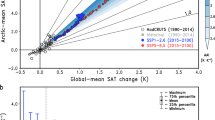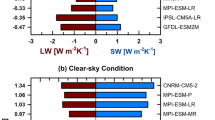Abstract
Pronounced warming in the Arctic region, coined Arctic amplification, is an important feature of observed and modelled climate change1,2. Arctic amplification is generally attributed to the retreat of sea-ice3 and snow, and the associated surface-albedo feedback4, in conjunction with other processes5,6,7,8. In addition, the predominant thermal surface inversion in winter has been suggested to pose a negative feedback to Arctic warming by enhancing infrared radiative cooling9. Here we use the coupled climate model EC-Earth10 in idealized climate change experiments to quantify the individual contributions of the surface and the atmosphere to infrared radiative cooling. We find that the surface inversion in fact intensifies Arctic amplification, because the ability of the Arctic wintertime clear-sky atmosphere to cool to space decreases with inversion strength. Specifically, we find that the cold layers close to the surface in Arctic winter, where most of the warming takes place, hardly contribute to the infrared radiation that goes out to space. Instead, the additional radiation that is generated by the warming of these layers is directed downwards, and thus amplifies the warming. We conclude that the predominant Arctic wintertime temperature inversion damps infrared cooling of the system, and thus constitutes a positive warming feedback.
This is a preview of subscription content, access via your institution
Access options
Subscribe to this journal
Receive 12 print issues and online access
$259.00 per year
only $21.58 per issue
Buy this article
- Purchase on Springer Link
- Instant access to full article PDF
Prices may be subject to local taxes which are calculated during checkout




Similar content being viewed by others
References
Holland, M. M. & Bitz, C. M. Polar amplification of climate change in coupled models. Clim. Dyn. 21, 221–232 (2003).
Serreze, M. C., Barrett, A. P., Stroeve, J. C., Kindig, D. N. & Holland, M. M. The emergence of surface-based Arctic amplification. Cryosphere 3, 11–19 (2009).
Screen, J. A. & Simmonds, I. The central role of diminshing sea ice in recent Arctic temperature amplification. Nature 464, 1334–1337 (2010).
Hall, A. The role of surface albedo feedback in climate. J. Clim. 17, 1550–1568 (2004).
Winton, M. Surface albedo feedback estimates for the AR4 climate models. J. Clim. 19, 359–365 (2006).
Lu, J. & Cai, M. Quantifying contributions to polar warming amplification in an idealized coupled general circulation model. Clim. Dyn. 34, 669–687 (2009).
Graversen, R. G., Mauritsen, T., Tjernström, M., Källén, E. & Svensson, G. Vertical structure of recent Arctic warming. Nature 541, 53–56 (2008).
Graversen, R. G. & Wang, M. Polar amplification in a coupled climate model with locked albedo. Clim. Dyn. 33, 629–643 (2009).
Boé, J., Hall, A. & Qu, X. Current GCM’s unrealistic negative feedback in the Arctic. J. Clim. 22, 4682–4695 (2009).
Hazeleger, W. et al. EC-Earth: A seamless Earth system prediction approach in action. Bull. Am. Meterol. Soc. 91, 1357–1363 (2010).
Gillett, N. P. et al. Attribution of polar warming to human influence. Nature Geosci. 1, 750–754 (2008).
Lu, J., Greatbatch, R. J. & Paterson, K. A. Trend in Northern Hemisphere winter atmospheric circulation during the last half of the twentieth century. J. Clim. 17, 3745–3760 (2006).
Honda, M., Inoue, J. & Yamane, S. Influence of low Arctic sea-ice minima on anomously cold Eurasian winters. Geophys. Res. Lett. 36, L08707 (2009).
Overland, J. E. & Wang, M. Large-scale atmospheric circulation changes are associated with recent loss of Arctic sea ice. Tellus 62, 1–9 (2009).
van den Broeke, M. R. et al. Partitioning recent Greenland Mass Loss. Science 326, 984–986 (2009).
Graversen, et al. Greenland’s contribution to global sea level rise by the end of the 21st century. Clim. Dyn. http://dx.doi.org/10.1007/s00382-010-0918-8 (2010).
Serreze, M. C. & Francis, J. A. The Arctic amplification debate. Clim. Change 76, 241–264 (2006).
Solomon, S. (ed.) in Climate Change 2006: The Physical Science Basis 996 (Cambridge Univ. Press, 2007).
Manabe, S. & Wetherald, R. T. The effect of doubling the CO2 concentration on the climate of a general circulation model. J. Atmos. Sci. 32, 5529–5554 (1975).
Alexeev, V. A., Langen, P. L. & Bates, J. R. Polar amplification of surface warming on an aquaplanet in ghost forcing experiments without sea ice feedbacks. Clim. Dyn. 24, 655–666 (2005).
Deser, C., Tomas, R., Alexander, M. & Lawrence, D. The seasonal atmospheric response to projected arctic sea ice loss in the late twenty-first century. J. Clim. 23, 333–351 (2010).
Dmitrenko, I. et al. Towards a warmer Arctic Ocean: Spreading of the early 21st century Atlantic water warm anomaly along the Eurasian Basin margins. J. Geophys. Res. 113, C05023 (2008).
Spielhagen, R. F. et al. Enhanced modern heat transfer to the Arctic by warm Atlantic water. Science 331, 450–253 (2011).
Bony, S. et al. How well do we understand and evaluate climate change feedback processes? J. Clim. 19, 3445–3482 (2006).
Meehl, G. A. et al. Response of the NCAR climate system model to increased CO2 and the role of physical processes. J. Clim. 13, 1879–1898 (2000).
King, J. C. Longwave atmospheric radiation over Antarctica. Ant. Sci. 8, 105–109 (1996).
Lu, J. & Cai, M. Seasonality of polar surface warming amplification in climate simulations. Geophys. Res. Lett. 36, L16704 (2009).
Gregory, J. et al. A new method for diagnosing radiative forcing and climate sensitivity. Geophys. Res. Lett. 31, L03205 (2004).
Viterbo, P., Beljaars, A. C. M., Mahouf, J-F. & Teixeira, J. The representation of soil moisture freezing and its impact on the stable boundary layer. Q. J. R. Meteorol. Soc. 125, 2401–2426 (1999).
Acknowledgements
We are grateful to all members of the EC-Earth consortium for their help and support with the development of the EC-Earth climate model. R.G.G. is funded by the Ministry of Transport, Public Works and Water Management, The Netherlands, within the project Abrupt Climate Change, and by FORMAS, Sweden, through the ADSIMNOR project.
Author information
Authors and Affiliations
Contributions
R.B. and R.G.G. developed the ideas that lead to this paper. R.B. conducted the climate model experiments and analyses, and wrote the main paper and the Supplementary Information. All authors discussed the results and implications and commented on the manuscript at all stages.
Corresponding author
Ethics declarations
Competing interests
The authors declare no competing financial interests.
Supplementary information
Supplementary Information
Supplementary Information (PDF 554 kb)
Rights and permissions
About this article
Cite this article
Bintanja, R., Graversen, R. & Hazeleger, W. Arctic winter warming amplified by the thermal inversion and consequent low infrared cooling to space. Nature Geosci 4, 758–761 (2011). https://doi.org/10.1038/ngeo1285
Received:
Accepted:
Published:
Issue Date:
DOI: https://doi.org/10.1038/ngeo1285
This article is cited by
-
Relationships among Arctic warming, sea-ice loss, stability, lapse rate feedback, and Arctic amplification
Climate Dynamics (2023)
-
The Arctic has warmed nearly four times faster than the globe since 1979
Communications Earth & Environment (2022)
-
Arctic amplification, and its seasonal migration, over a wide range of abrupt CO2 forcing
npj Climate and Atmospheric Science (2022)
-
Rise and fall of sea ice production in the Arctic Ocean’s ice factories
Nature Communications (2022)
-
Climatology of Arctic temperature inversions in current and future climates
Theoretical and Applied Climatology (2022)



